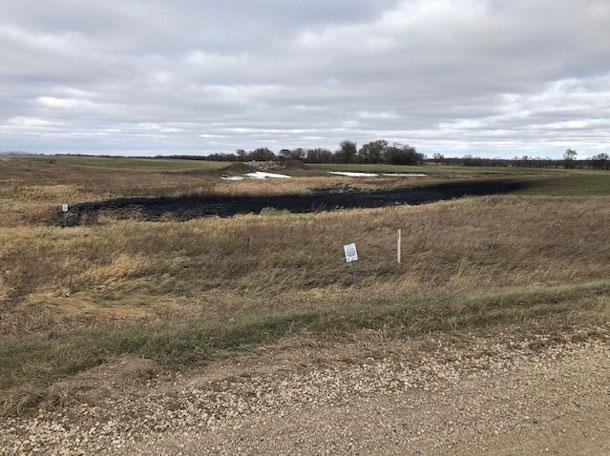Keystone oil spill casts doubt on the safety of proposed Keystone XL pipeline
The Keystone pipeline spilled nearly 400,000 gallons of tar sands oil into a wetland in Walsh County, North Dakota.
On Oct. 29, 2019, a nearly 400,000-gallon oil spill was discovered in the Keystone pipeline system in North Dakota. The spill inundated a wetland with heavy crude oil mined from the Alberta tar sands.
Report of the spill came on the same day Keystone operator, TC Energy, was assuring regulators at a hearing that it has properly considered the environmental and safety impacts of its controversial proposed pipeline extension, known as Keystone XL.
Keystone XL would bring tar sands oil from Alberta through North Dakota all the way to the Gulf Coast in Texas. The project has been in and out of the courts for years and continues to be a point of protest, especially for Native Americans in the region.
Related: The Keystone XL pipeline gets a victory, but with a question mark
TC Energy’s history of safety with its pipelines has not been stellar. Keystone came online in 2010, billed as state-of-the-art technology and one of the safest pipelines ever built. It spilled 35 times in its first year alone — 14 times in the US and 21 times in Canada, reports Doug Hayes, a senior attorney at the Sierra Club.
“Then, in the last few years, we’ve seen at least four significant spills,” Hayes adds. “A lot of these seem to have been caused by problems created during construction.”
The larger issue, Hayes says, is that Keystone XL would cross more than 1,000 waterways, including the Missouri River, near the Fort Peck Assiniboine and Sioux Tribes reservation in Montana. The pipeline would cross under the river just upstream of the area’s water supply system.
“That’s just one of many places where a spill would cause catastrophic damage,” Hayes says. “Also, the pipeline would cross the Ogallala Aquifer and other important water resources in Nebraska and other places along the pipeline route.”
Oil pipelines that carry tar sands crude oil pose unique risks, Hayes says, because tar sands oil is what’s known as diluted bitumen, which behaves differently than oil when released into waterways. When conventional crude oil spills into waterways, much of it floats on top, so certain spill-response mechanisms, such as skimmers and booms, can help contain the spill. Tar sands crude oil is heavier and elements of it separate out and sink to the bottom, rendering traditional cleanup technologies ineffective.
Some scientific studies have disputed this characterization of how diluted bitumen reacts with water, however, and scientists disagree on which type of spill is worse for the environment.
In addition to the risk the pipeline poses to waterways, a federal judge in Montana ruled last year that the State Department had not adequately analyzed the risk of oil spills to endangered species, Hayes says. A leak anywhere along the pipeline would have significant impacts on species that live along the route.
Related: Judge halts Keystone XL pipeline on climate change grounds
A coalition of environmental groups, including the Sierra Club, the Natural Resources Defense Council, the Center for Biological Diversity and the Bold Alliance, have filed a lawsuit in federal court in Montana against the US Army Corps of Engineers.
The suit argues that the Army Corps approved the vast majority of the pipeline’s water crossings in four states “without doing any meaningful environmental review, without allowing the public to be involved, without evaluating oil spills at all,” Hayes says. “It’s a streamlined process that the corps uses called Nationwide Permit 12. It’s sort of a blanket approval and that’s what the lawsuit is challenging.”
TC Energy has not yet begun construction of the Keystone XL pipeline.
The injunction imposed by the federal court in Montana prevented them from beginning work in 2019. They began to do some pre-construction work, Hayes notes, like building worker camps and stocking pipes, but in September, the company announced it would not do any further pre-construction this year.
Future efforts to complete the Keystone XL pipeline project may depend on who occupies the White House in January 2021.
Since 1968, the State Department controlled the permitting process over cross-border pipelines like Keystone XL. But Last year, Hayes says, President Donald Trump “threw that out the window” and signed his own permit, bypassing the State Department process.
“I think because he essentially scrapped the process altogether and made a unilateral decision, that really opens the door to the potential for an incoming president to reverse that decision,” Hayes says.
This article is based on an interview that aired on PRI’s Living on Earth with Steve Curwood.
